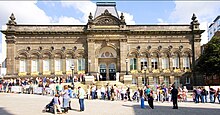
Leeds Mechanics' Institute was a mechanics' institute founded in 1824 in Leeds, West Yorkshire, England, [1] and is one of the predecessor institutions of Leeds Beckett University [2] and Leeds Arts University.

Leeds Mechanics' Institute was a mechanics' institute founded in 1824 in Leeds, West Yorkshire, England, [1] and is one of the predecessor institutions of Leeds Beckett University [2] and Leeds Arts University.
The institute was founded by members of the Leeds Philosophical and Literary Society who wished to offer educational opportunities to the working class. Initially it occupied two rooms, a library and a lecture room, in a house on Park Row. [3] [4] [5]
| | This section needs expansion. You can help by adding to it. (December 2023) |
In 1824, the Leeds Mechanics' Institute (LMI) remained under the stewardship of its proprietors, prominent figures in Leeds such as Baines, Kitson, and Marshall. While the institute was primarily sustained by annual subscribers, reflecting Victorian class distinctions, its membership fees varied based on individuals' financial capabilities. Affluent members paid 15 shillings per year, payable in installments, while the Mechanics Class, with its more modest means, paid either 12 shillings or 8 shillings annually. Subscribers enjoyed access to a well-stocked library and a reading room. The core curriculum consisted of Writing and Grammar, French, Geography, Chemistry and Mathematics. Over time more classes were added. [3] Additionally, the institute hosted a diverse array of lectures as part of its Autumn and Winter annual program, delivered by both LMI members and visiting speakers. Annual social events like mid-Winter evening soirees and Summer excursions to places like Castle Howard and Wentworth Castle were also a part of the institute's offerings. By 1860s some employers offered their workers classes at a reduced rate. One organization had around 100 employees enrolled. [3]
The architect Cuthbert Brodrick, [6] known for his design of the neighboring Town Hall, was tasked with creating a new edifice on Cookridge Street, now known as Millennium Square. The construction of this building spanned five years and incurred a cost of £20,000. At the heart of this structure, crafted in the French Second Empire style, stood a lecture hall capable of seating 1,500 individuals, its balcony supported by cast iron columns. Surrounding this focal point, on two levels, were facilities including a library, reading room, classrooms, laboratory, art studio, and a dining area. Over time, the Institute evolved into Leeds College of Art in 1903, with subsequent modifications to its interior throughout the 20th century, notably converting the lecture hall into a theatre. Recognized with a Grade II* listing, the building presently serves as the city's museum, with the central circular lecture theatre repurposed into exhibition space.
By 1907 most further education in Leeds was in the hands of the council, with the establishment of the Leeds College of Art, Leeds College of Technology (later Kitson College) and Leeds College of Commerce (later Park Lane College). [5] The main activities of the Leeds Institute, as it was now named, after 1907 included a lecture series, a library for its subscribers, and a cafe. The Leeds Institute struggled financially and in 1912 obtained the permission of the Charity Commission to sell its building and land to Leeds Corporation, for a sum ("not less than £39,000") large enough to clear its debts. It arranged to rent the building from the corporation. In 1940, the Leeds Institute had a dwindling membership and was unable, due to war-time restrictions, to hold its usual evening lectures. It went into voluntary liquidation and ceased to exist, with the lease on the building being surrendered to the landlord, Leeds Education Committee, for £2,310 9s 6d on 21 May 1940. [5]
A 2019 thesis from the University of Huddersfield includes a "genealogy" diagram showing the intermediate stages by which the Mechanics' Institution (its initial name) led to the formation of Leeds Beckett University and Leeds Arts University, while its premises now house Leeds City Museum. [7] : 265

The Leeds Mechanics' Institute building, designed by Cuthbert Brodrick, was built in 1865–1868 in Cookridge Street. [8] The building is now grade II* listed, [9] and since 2008 has been the home of Leeds City Museum. [10] Before housing the museum, the building had several educational and cultural uses, including housing Leeds Civic Theatre and some departments of what was then the Leeds College of Music.

The University of Manchester Institute of Science and Technology (UMIST) was a university based in the centre of the city of Manchester in England. It specialised in technical and scientific subjects and was a major centre for research. On 1 October 2004, it amalgamated with the Victoria University of Manchester to produce a new entity called the University of Manchester.
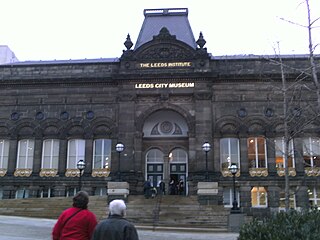
Mechanics' institutes, also known as mechanics' institutions, sometimes simply known as institutes, and also called schools of arts, were educational establishments originally formed to provide adult education, particularly in technical subjects, to working men in Victorian-era Britain and its colonies. They were often funded by local industrialists on the grounds that they would ultimately benefit from having more knowledgeable and skilled employees. The mechanics' institutes often included libraries for the adult working class, and were said to provide them with an alternative pastime to gambling and drinking in pubs.

George Birkbeck FRS was a British physician, academic, philanthropist, pioneer in adult education and a professor of natural philosophy at the Andersonian Institute. He is the founder of Birkbeck, University of London and was head of the Chemical Society. He is one of the creators of the earliest chemistry laboratory for undergraduates at University College London, and is also known for the creation of mechanics' institutes in Scotland and London. He was President of the Medical and Chirurgical Society of London in 1825.

Leeds Beckett University (LBU), formerly known as Leeds Metropolitan University (LMU) and before that as Leeds Polytechnic, is a public university in Leeds, West Yorkshire, England. It has campuses in the city centre and Headingley. The university's origins can be traced to 1824, with the foundation of the Leeds Mechanics Institute. Leeds Polytechnic was formed in 1970, and was part of the Leeds Local Education Authority until it became an independent Higher Education Corporation on 1 April 1989. In 1992, the institution gained university status. The current name was adopted in September 2014.
Kitson and Company was a locomotive manufacturer based in Hunslet, Leeds, West Yorkshire, England.

Cuthbert Brodrick FRIBA was a British architect, whose most famous building is Leeds Town Hall.

Millennium Square is a city square in the Civic Quarter of Leeds, West Yorkshire, England. It was Leeds's flagship project to mark the year 2000, and was jointly funded by Leeds City Council and the Millennium Commission. Total cost of production was £12 million.

A subscription library is a library that is financed by private funds either from membership fees or endowments. Unlike a public library, access is often restricted to members, but access rights can also be given to non-members, such as students.

Albert Ernest Kitson, 2nd Baron Airedale was a British peer. He was inter alia a director of Midland Bank.

Leeds College of Technology was a further education college in Leeds, in West Yorkshire, England. With a strong technical bias, the college supported the computing, engineering, social care and transport industries. In addition, the college was a national centre for print training and offered English language learning and teaching (ESOL). The Woodhouse Lane building was built in 1957 and opened in 1959, it was part of Leeds City College until June 2019 when the college closed after 60 years of activity and these facilities were moved to a brand new campus at Quarry Hill opposite the bus station.

Leeds Town Hall is a 19th-century municipal building on The Headrow, Leeds, West Yorkshire, England. Planned to include law courts, a council chamber, offices, a public hall, and a suite of ceremonial rooms, it was built between 1853 and 1858 to a design by the architect Cuthbert Brodrick. With the building of the Civic Hall in 1933, some of these functions were relocated, and after the construction of the Leeds Combined Court Centre in 1993, the Town Hall now serves mainly as a concert, conference and wedding venue, its offices still used by some council departments. It was designated a Grade I listed building in 1951.

Leeds Art Gallery in Leeds, West Yorkshire, England, is a gallery, part of the Leeds Museums & Galleries group, whose collection of 20th-century British Art was designated by the British government in 1997 as a collection "of national importance". Its collection also includes 19th-century and earlier art works. It is a grade II listed building owned and administered by Leeds City Council, linked on the West to Leeds Central Library and on the East via a bridge to the Henry Moore Institute with which it shares some sculptures. A Henry Moore sculpture, Reclining Woman: Elbow (1981), stands in front of the entrance. The entrance hall contains Leeds' oldest civic sculpture, a 1712 marble statue of Queen Anne.

Leeds City Museum, originally established in 1819, reopened in 2008 in Leeds, West Yorkshire, England. It is housed in the former Mechanics' Institute built by Cuthbert Brodrick, in Cookridge Street. It is one of nine sites in the Leeds Museums & Galleries group.
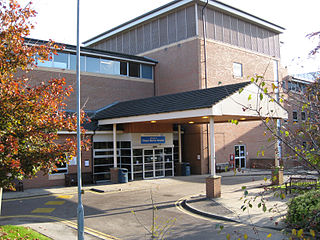
Chapel Allerton Hospital is located in the area of Chapel Allerton, Leeds, West Yorkshire, England and is operated by the Leeds Teaching Hospitals NHS Trust. The main entrance is on Chapeltown Road, with vehicle exits onto Harehills Lane and Newton Road.

Leeds Philosophical and Literary Society is a learned society in Leeds, West Yorkshire, England. It was founded in 1819, and its museum collection forms the basis of Leeds City Museum, which reopened in September 2008. The printed works and papers of the society are held by Leeds University Library. The Society is a registered charity under English law.

The Bradford Mechanics' Institute Library was established in Bradford, England, in 1832 as part of a national initiative to provide adult education especially in technical subjects for working men. The institute in Bradford was supported by numerous local worthies, including James Hanson after whom is named one of Bradford's largest high schools.
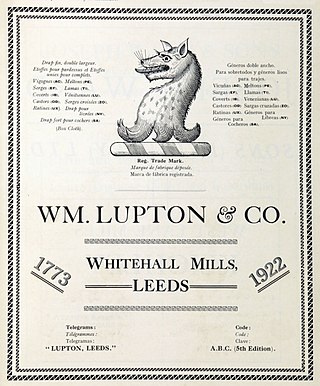
The Lupton family in Yorkshire achieved prominence in ecclesiastical and academic circles in England in the Tudor era through the fame of Roger Lupton, provost of Eton College and chaplain to Henry VII and Henry VIII. By the Georgian era, the family was established as merchants and ministers in Leeds. Described in the city's archives as "landed gentry, a political and business dynasty", they had become successful woollen cloth merchants and manufacturers who flourished during the Industrial Revolution and traded throughout northern Europe, the Americas and Australia.

Headingley Hill Congregational Church is a redundant Congregational church at the corner of Headingley Lane and Cumberland Road, in the Headingley area of Leeds, West Yorkshire, England. The church, which is a Grade II listed building, was designed in the Gothic Revival style by Cuthbert Brodrick and completed in 1866. It was the only church to have been designed by Brodrick, who is noted for Leeds Town Hall and the Corn Exchange.
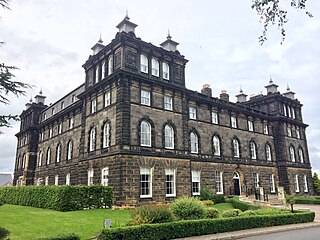
Wells House is a large former hydropathic establishment and hotel in Ilkley, West Yorkshire, England, now used as private apartments. It was built in 1854–56 to a design by the architect Cuthbert Brodrick and is a Grade II listed building. It is located above the town on Wells Road at the edge of Ilkley Moor, giving it an unobstructed view across Wharfedale from its north front. It was originally set in grounds by the landscaper Joshua Major though these gardens have mostly been built on since.
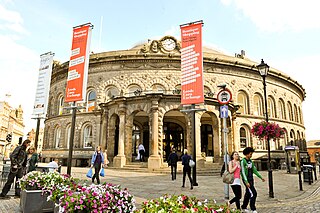
Rushbond plc is an unlisted commercial and residential property development and investment company in the United Kingdom. It was founded in Leeds, West Yorkshire in 1986 by Jonathan W Maud and exclusively operates around the Leeds City Region, into which it invested £14.3 million in 2019. The company, though specialising in the conversion and redevelopment of listed heritage buildings, also engages in the construction of new-build property and acquisitions.
53°48′06″N01°32′49″W / 53.80167°N 1.54694°W